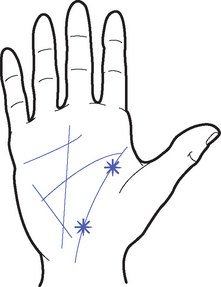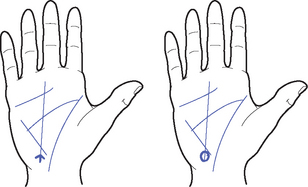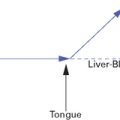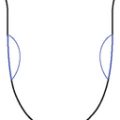 OBSERVATION OF THE HANDS
OBSERVATION OF THE HANDS
INTRODUCTION
Observation of the hands has always formed a relatively important aspect of diagnosis and it is mentioned in several chapters of the ‘Simple Questions’ and ‘Spiritual Axis’ as well as in the ‘Discussion of Origin of Symptoms in Diseases’ (Zhu Bing Yuan Huo Lun, AD610 by Chao Yuan Fang).1 The description of index finger diagnosis in children was discussed by the Tang dynasty doctor Wang Chao in the book ‘Illustrated Formula of the Water Mirror’ (Shui Jing Tu Jue).2
A more detailed description of the hand signs and symptoms described below can be found in Part 5, Chapter 65.
ABNORMAL COLOUR
VENULES ON THE THENAR EMINENCE
Symptoms and Signs, Chapter 65
The thenar eminence shows the state of the Stomach. Chapter 10 of the ‘Spiritual Axis’ relates the colour of the thenar eminence to the state of the Stomach and says: ‘When the Stomach has Cold, the thenar eminence is bluish; when the Stomach has Heat, the thenar eminence is reddish; if it is suddenly black, it indicates chronic Painful Obstruction Syndrome; if it is sometimes red, sometimes dark and sometimes bluish it indicates alternation of Heat and Cold; if it is bluish and short, it indicates deficiency of Qi.’3 Chapter 74 of the same book says: ‘When the thenar eminence has bluish venules, it indicates Cold in the Stomach.’4
TREMOR OF THE HANDS
Symptoms and Signs, Chapter 65
Box 14.1 summarizes patterns underlying hand tremor.
TINEA (RINGWORM)
Observation, Chapter 21; Symptoms and Signs, Chapters 65 and 77
When tinea affects the nails, in Chinese medicine it is called Goose Claw Wind.
THE FINGERS
Contraction of the fingers
Symptoms and Signs, Chapter 65
Contraction of the fingers with normal movement of the wrist joint and all the joints above it is called Chicken Claw Wind. The most common cause of this contraction of the fingers is Liver-Blood or Liver-Yin deficiency; the Dupuytren contraction of the ring or little finger is a typical example of it (Fig. 14.1).
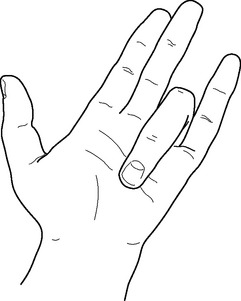
Fig. 14.1 Contraction of the ring finger
Two other causes of contraction of the fingers are Cold in the joints or stagnation of Qi from emotional problems; in the latter case the contraction of the fingers comes and goes according to the emotional state.
Box 14.2 summarizes patterns underlying contraction of the fingers.
Spoon-shaped fingers
Symptoms and Signs, Chapter 65
Spoon-shaped fingers (Fig. 14.2) usually indicate a Lung pathology, which may be Cold-Phlegm in the Lungs, Phlegm-Heat in the Lungs, or Lung and Kidney-Yin deficiency. They are usually seen only in patients suffering from chronic lung diseases such as emphysema, tuberculosis (TB) of the lungs, or chronic obstructive pulmonary disease. In some cases, spoon-shaped fingers may also indicate a Heart pathology.
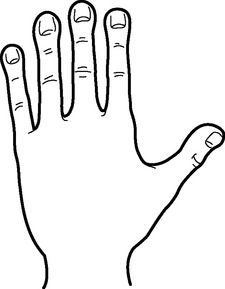
Fig. 14.2 Spoon-shaped fingers
Thin, pointed fingers
Symptoms and Signs, Chapter 65
Thin, pointed fingers are generally related to the state of the Stomach (Fig. 14.3) and may indicate Cold-Dampness in the Stomach, Damp-Heat in the Stomach or severe deficiency of Stomach- and Spleen-Qi.
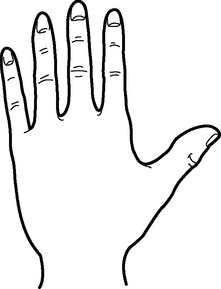
Fig. 14.3 Thin, pointed fingers
Swollen fingers
Symptoms and Signs, Chapter 65
The most obvious and common cause of swelling of the fingers is Painful Obstruction Syndrome from Dampness, which may be Cold-Dampness, Wind-Dampness or Damp-Heat. Other causes of swelling of the fingers include Blood stasis (of the Heart or Liver) or oedema, which, in the case of the hands, is due to deficiency of Yang of the Lungs and Spleen. In the elderly, swollen fingers may also be due to Liver- and Kidney-Yin deficiency with Blood-Heat (Fig. 14.4).
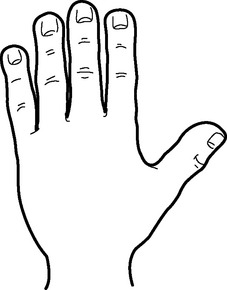
Fig. 14.4 Swollen fingers
Box 14.3 summarizes patterns underlying swollen fingers.
DEFORMED KNUCKLES
Symptoms and Signs, Chapter 65
Deformed knuckles are seen in the late, chronic stages of Painful Obstruction Syndrome with Phlegm. In chronic Painful Obstruction Syndrome, there is a severe disruption of the transformation and movement of the fluids in the joints which, under the ‘steaming’ action of Heat, creates Phlegm in the joints. Thus, Phlegm is the central pathogenic factor causing deformed knuckles; it may be combined with other conditions such as Heat, Cold, Blood stasis or Qi or Yin deficiency, or both (Fig. 14.5).
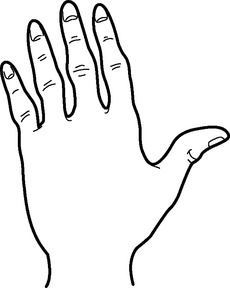
Fig. 14.5 Deformed knuckles
THE PALMS
Hand lines
Changes in the lines of the palms of the hands can indicate certain pathologies.
Description of the lines
The main hand lines to be observed are illustrated in Figure 14.6. The lines are the life line, the head line, the emotions line, the health line and the so-called Jade Pillar. Figure 14.7 illustrates the normal lengths of the emotions line and life line.
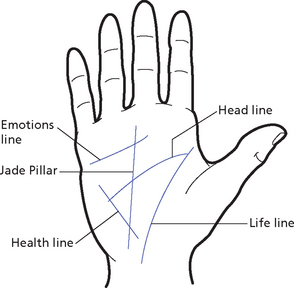
Fig. 14.6 Main hand lines
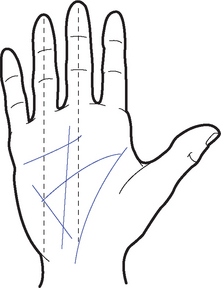
Fig. 14.7 Normal length of emotions and life lines
Description of abnormal signs on the lines
The abnormal signs appearing on the lines may be shaped like stars, crosses, triangles, ovals, squares, hashes, links of a chain or rope (Fig. 14.8).
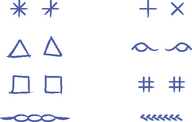
Fig. 14.8 Abnormal signs on the lines
Diseases indicated on the lines
The diseases indicated on the lines are as follows:
Diseases of the digestive system
In ulcerative colitis, there is a star-shaped sign on the distal or proximal end of the life line (Fig. 14.9).
In gastritis, there is a star-shaped sign on the proximal end of the life line (Fig. 14.9).
Circulatory diseases
In hypertension, the emotions line extends radially beyond its natural boundary (Fig. 14.10).
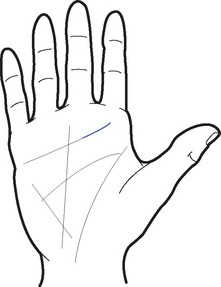
Fig. 14.10 Lines showing hypertension
In coronary heart disease; both the emotions line and the head line are shorter than normal (Fig. 14.11).
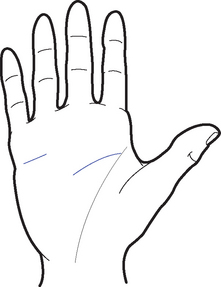
Fig. 14.11 Lines showing coronary heart disease
Respiratory diseases
In asthma, there are oval-shaped signs at either end of the health line (Fig. 14.12).
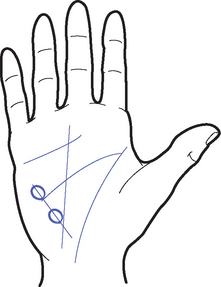
Fig. 14.12 Signs on the health line in asthma
In TB of the lungs, there are oval-shaped signs in the middle of the health line (Fig. 14.13).
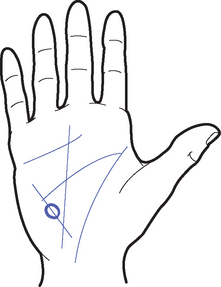
Fig. 14.13 Signs on the health line in TB of the lungs
Diseases of the urinary system
In nephritis, urinary infections, prostatitis, or prostatic hypertrophy, there is an oval-shaped sign at the proximal end of the life line (Fig. 14.14).
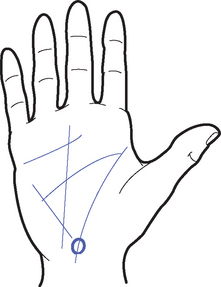
Fig. 14.14 Signs on the life line in urinary diseases
Diseases of the reproductive system
In endometriosis, salpingitis, myomas, or ovarian cysts, there is an arrow-shaped or oval sign at the proximal end of the Jade Pillar (Fig. 14.15).
In erectile dysfunction or impotence, there are horizontal chain links near the proximal end of the life line (Fig. 14.16).
NOTES
1. Sheng, Zhang Shu. Great Treatise of Diagnosis by Observation in Chinese Medicine (Zhong Hua Yi Xue Wang Zhen Da Quan  ). Taiyuan: Shanxi Science Publishing House, 1995.
). Taiyuan: Shanxi Science Publishing House, 1995.
2. Sheng, Zhang Shu. Great Treatise of Diagnosis by Observation in Chinese Medicine (Zhong Hua Yi Xue Wang Zhen Da Quan  ). Taiyuan: Shanxi Science Publishing House, 1995.
). Taiyuan: Shanxi Science Publishing House, 1995.
3. Spiritual Axis (Ling Shu Jing  ). People’s Health Publishing House: Beijing, 1981:129 Para 37. First published c. 100BC.
). People’s Health Publishing House: Beijing, 1981:129 Para 37. First published c. 100BC.
4. Spiritual Axis (Ling Shu Jing  ). People’s Health Publishing House: Beijing, 1981; 133.
). People’s Health Publishing House: Beijing, 1981; 133.

